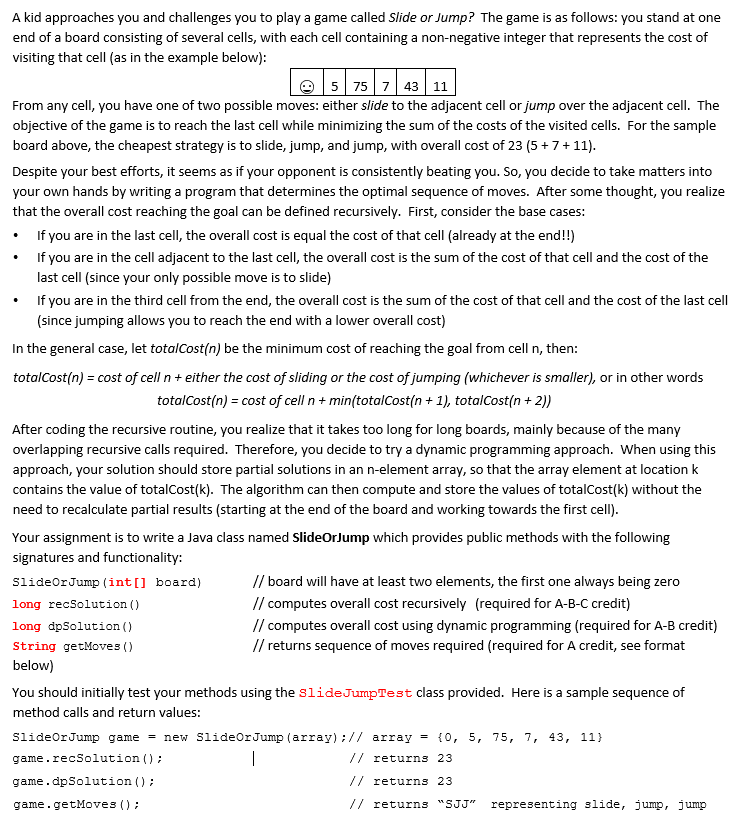Question
JAVA Programming: Instruction for the JAVA Programming: 1) Make a SlideOrJump.java solution About the program: 2) Test the above program with SJTest.java (SlideJumpTest) import java.util.Arrays;
JAVA Programming:
Instruction for the JAVA Programming:
1) Make a SlideOrJump.java solution
About the program: 
2) Test the above program with SJTest.java (SlideJumpTest)
import java.util.Arrays;
/** Program to test the functionality of the SlideOrJump class. */ public class SJTest { public static void main(String [] args) { int [] test0 = {0, 5, 75, 7, 43, 11}; int [] test1 = {0, 5}; int [] test2 = {0, 5, 75}; int [] test3 = {0, 5, 75, 7, 43, 11, 12, 45, 32, 21, 45, 21, 76, 43, 23, 42, 7, 5, 20}; SlideOrJump board0 = new SlideOrJump(test0); SlideOrJump board1 = new SlideOrJump(test1); SlideOrJump board2 = new SlideOrJump(test2); SlideOrJump board3 = new SlideOrJump(test3); System.out.println(" Board: " + Arrays.toString(test0) + " Recursive Sol Cost: " + board0.recSolution()); System.out.println("Dyn Prog Sol Cost: " + board0.dpSolution() + " Moves: " + board0.getMoves()); System.out.println(" Board: " + Arrays.toString(test1) + " Recursive Sol Cost: " + board1.recSolution()); System.out.println("Dyn Prog Sol Cost: " + board1.dpSolution() + " Moves: " + board1.getMoves()); System.out.println(" Board: " + Arrays.toString(test2) + " Recursive Sol Cost: " + board2.recSolution()); System.out.println("Dyn Prog Sol Cost: " + board2.dpSolution() + " Moves: " + board2.getMoves()); System.out.println(" Board: " + Arrays.toString(test3) + " Recursive Sol Cost: " + board3.recSolution()); System.out.println("Dyn Prog Sol Cost: " + board3.dpSolution() + " Moves: " + board3.getMoves()); } }
A kid approaches you and challenges you to play a game called Slide or Jump? The game is as follows: you stand at one end of a board consisting of several cells, with each cell containing a non-negative integer that represents the cost of visiting that cell (as in the example below): 5 75 743 11 From any cell, you have one of two possible moves: either slide to the adjacent cell or jump over the adjacent cell. The objective of the game is to reach the last cell while minimizing the sum of the costs of the visited cells. For the sample board above, the cheapest strategy is to slide, jump, and jump, with overall cost of 23 (5 + 7 + 11). Despite your best efforts, it seems as if your opponent is consistently beating you. So, you decide to take matters into your own hands by writing a program that determines the optimal sequence of moves. After some thought, you realize that the overall cost reaching the goal can be defined recursively. First, consider the base cases: If you are in the last cell, the overall cost is equal the cost of that cell (already at the end!!) If you are in the cell adjacent to the last cell, the overall cost is the sum of the cost of that cell and the cost of the last cell (since your only possible move is to slide) If you are in the third cell from the end, the overall cost is the sum of the cost of that cell and the cost of the last cell (since jumping allows you to reach the end with a lower overall cost) In the general case, let totalCost(n) be the minimum cost of reaching the goal from cell n, then: totalCost(n) = cost of cell n + either the cost of sliding or the cost of jumping (whichever is smaller), or in other words totalCost(n) = cost of cell n + min(totalCost(n + 1), totalCost(n + 2)) After coding the recursive routine, you realize that it takes too long for long boards, mainly because of the many overlapping recursive calls required. Therefore, you decide to try a dynamic programming approach. When using this approach, your solution should store partial solutions in an n-element array, so that the array element at location k contains the value of totalCost(k). The algorithm can then compute and store the values of totalCost(k) without the need to recalculate partial results (starting at the end of the board and working towards the first cell). Your assignment is to write a Java class named SlideOrJump which provides public methods with the following signatures and functionality: SlideOrJump (int[] board) // board will have at least two elements, the first one always being zero long recSolution() // computes overall cost recursively (required for A-B-C credit) long dpSolution() // computes overall cost using dynamic programming (required for A-B credit) String getMoves () // returns sequence of moves required (required for A credit, see format below) You should initially test your methods using the slide JumpTest class provided. Here is a sample sequence of method calls and return values: SlideOrJump game = new SlideOrJump (array);// array = {0, 5, 75, 7, 43, 11} game. recSolution(); | // returns 23 game.dpSolution(); // returns 23 game.getMoves(); // returns "SJJ" representing slide, jump, jumpStep by Step Solution
There are 3 Steps involved in it
Step: 1

Get Instant Access to Expert-Tailored Solutions
See step-by-step solutions with expert insights and AI powered tools for academic success
Step: 2

Step: 3

Ace Your Homework with AI
Get the answers you need in no time with our AI-driven, step-by-step assistance
Get Started


